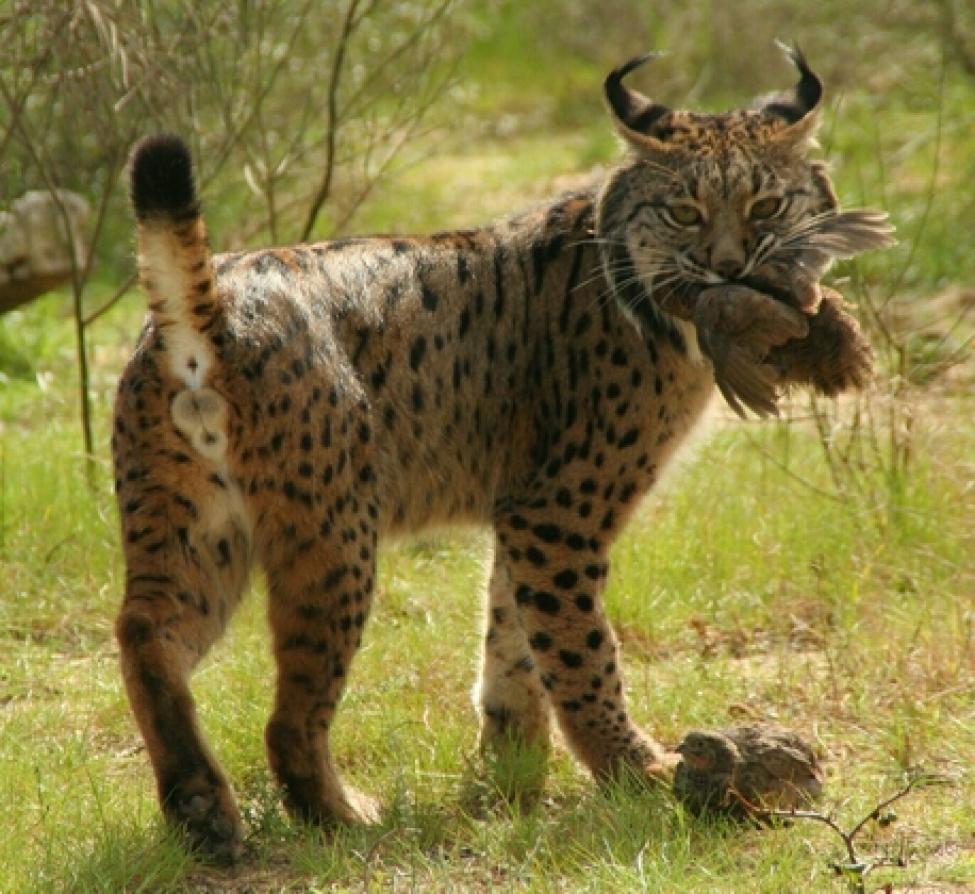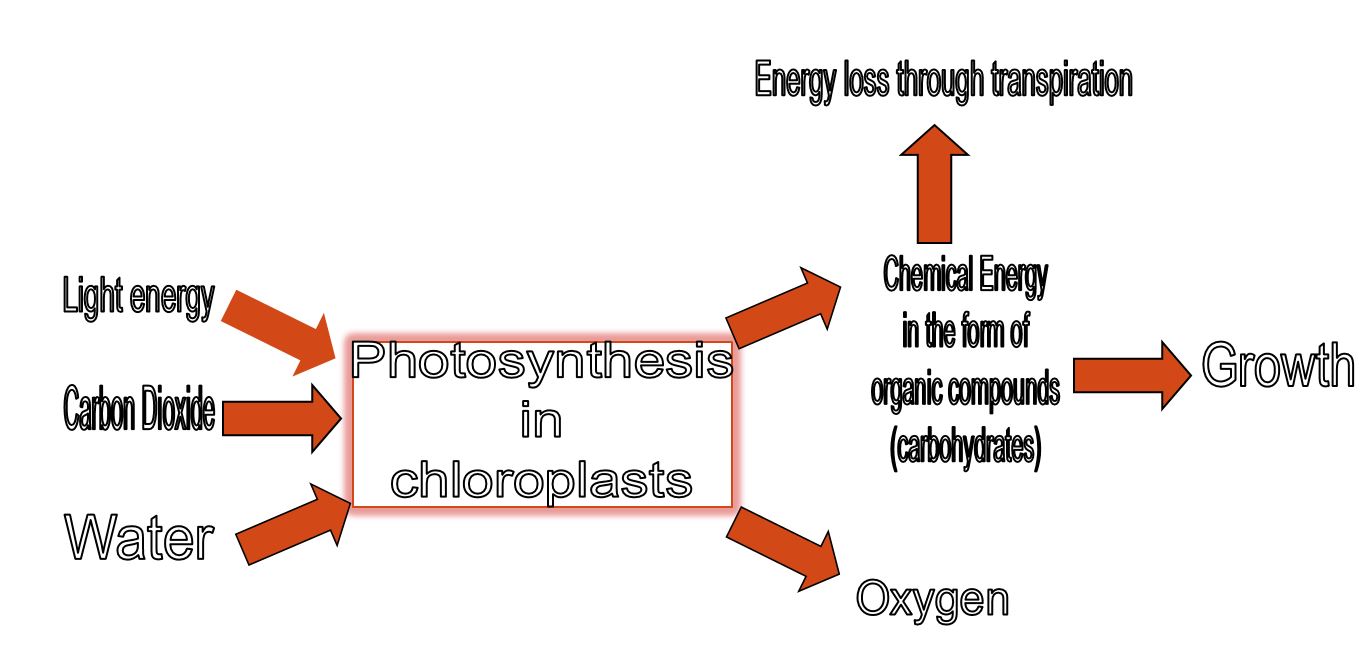2.2 Energy Flow and Feeding Relationships
 Introducing Feeding Relationships
Introducing Feeding Relationships
I start this section by reminding students of the first and second laws of thermodynamics that they learned about in Structure of a System but this could easily be embedded into a unit based on these ecological principles. This is personal preference and could be a time saving trick.
We have some pond weed set up in the lab and see the bubbles being produced by the plant under water. This is outlined in Introducing Primary Productivity. This allows us to quickly think about the concepts of photosynthesis, respiration and the production of biomass.
Next we introduce the formal language of feeding relationships and how these can be illustrated. Students are then tasked with producing their own examples of food chains and food webs, embedded in real ecosystems. It is important that students can use descriptive language about the organisms in their food chains, so oak tree not just tree.
Beyond this exercise I use the excellent resources produced by HHMI Biointeractive on the Gorongosa Park.
Significant ideas:
- Photosynthesis and respiration play a significant role in the flow of energy in communities.
- The interactions of species with their environment result in energy and nutrient flows.
- The feeding relationships of species in a system can be modelled using food chains, food webs and ecological pyramids.
Recommended Teaching Time (not including practicals): 5 hours (whole sub-topic)
From the Guide (IB ESS Guide 2015):
- A community is a group of populations living and interacting with each other in a common habitat.
- An ecosystem is a community and the physical environment with which it interacts.
- Respiration and photosynthesis can be described as processes with inputs, outputs and transformations of energy and matter.
- Respiration is the conversion of organic matter into carbon dioxide and water in all living organisms, releasing energy. Aerobic respiration can be represented by the following word equation.
glucose + oxygen → carbon dioxide + water
- During respiration, large amounts of energy are dissipated as heat, increasing the entropy in the ecosystem while enabling organisms to maintain relatively low entropy and so high organization.
- Primary producers in most ecosystems convert light energy into chemical energy in the process of photosynthesis.
- The photosynthesis reaction is can be represented by the following word equation.
carbon dioxide + water → glucose + oxygen
- Photosynthesis produces the raw material for producing biomass.
- The trophic level is the position that an organism occupies in a food chain, or the position of a group of organisms in a community that occupy the same position in food chains.
- Producers (autotrophs) are typically plants or algae that produce their own food using photosynthesis and form the first trophic level in a food chain. Exceptions include chemosynthetic organisms that produce food without sunlight.
- Feeding relationships involve producers, consumers and decomposers. These can be modelled using food chains, food webs and ecological pyramids.
- The distinction between storages of energy illustrated by boxes in energy-flow diagrams (representing the various trophic levels), and the flows of energy or productivity often shown as arrows (sometimes of varying widths) needs to be emphasized. (Guidance)
- Details of chloroplasts, light-dependent and light-independent reactions, mitochondria, carrier systems, adenosine triphosphate (ATP) and specific intermediate biochemicals are not expected. (Guidance)
- This topic should be actively linked with sub-topic 1.3, as questions will arise requiring students to use their knowledge of thermodynamics with energy flow in ecosystems. (Guidance)
Student Tasks and Teaching Strategies
These are the activities for Energy Flow and Feeding Relationships
Review Laws of Thermodynamics
Refer to Structure of a System
Demonstrate Photosynthesis and generation of Productivity
Introducing Primary Productivity
Student Task on Food Chains
Activity to construct and analyse a variety of food chains 2.2 Feeding Relationships Review
Student Task on Mozambique and Supporting HHMI material
Students analyse the social and economic factors at play in Mozambique before completing an HHMI activity on food chains in Gorogosa National Park
First Law of Thermodynamics
Second Law of Thermodynamics
Photosynthesis
![By At09kg : original Wattcle : vector graphics (This file was derived from Photosynthesis.gif:) [CC BY-SA 4.0 (http://creativecommons.org/licenses/by-sa/4.0)], via Wikimedia Commons](/media/ib/ess/images/Small-Files/photosynthesis_en.svg.png) Photosynthesis is the biological process by which energy from the sun (radiant energy) is transformed into chemical energy in the form of sugar molecules.
Photosynthesis is the biological process by which energy from the sun (radiant energy) is transformed into chemical energy in the form of sugar molecules.
6CO2 + 6H2O → C6H12O6 + 6O2
These sugar molecules form the foundation of the biomass in most ecological systems.
The energy captured by plants via photosynthesis is transferred to the organisms that eat the plants on higher trophic levels.
Oxygen is a very important product of photosynthesis and provides an essential ecosystem service.
The chemical reaction of photosynthesis can be approached as a system, with inputs and outputs.

Respiration
 Cellular respiration is the process whereby chemical energy captured in photosynthesis is released within cells of plants and animals.
Cellular respiration is the process whereby chemical energy captured in photosynthesis is released within cells of plants and animals.
Glucose (a sugar molecule) reacts with oxygen to produce carbon dioxide, water and chemical energy.
C6H12O6 + 6O2 → 6CO2 + 6H2O (+ energy ATP)
This energy is used to do biological work such as creating new cells, reproduction, movement etc.
It is very important to note that the reaction of respiration produces a lot of energy in the form of heat which is dissipated (lost) from the organism, thus maintaining the the relatively low entropy of the organism but increasing the entropy in the whole system.
This illustrates the second law of thermodynamics.
Respiration can also be viewed as a system with inputs and outputs.
Feeding Relationships - Trophic Levels

The trophic level is the position that an organism occupies in a food chain or the position of a group of organisms in a community that occupy the same position in food chains.
In the diagram shown here, note that every trophic level can enter a decomposer food chain. Decomposers are considered to have their own food chains with their own trophic levels.
Primary or First Trophic Level
 These are always PRODUCERS - they make their own food. They are known as autotrophs (self feeders).
These are always PRODUCERS - they make their own food. They are known as autotrophs (self feeders).
Typically they are plants or algae using photosynthesis and so are known as Photoautotrophs.

Organisms also exist which can produce their own food without sunlight. These organisms use the chemical energy in chemical bonds to produce their sugars. These organisms are known as Chemoautotrophs.
Examples include the bacterial involved in the Nitrogen Cycle and those found in hydrothermal vents deep in the ocean or around geysirs.
Consumers - Secondary 2nd, Tertiary 3rd Trophic Levels


 These organisms obtain their energy by eathing autotrophs or other organisms. They are consumers and are also known as Heterotrophs (Mixed Feeders).
These organisms obtain their energy by eathing autotrophs or other organisms. They are consumers and are also known as Heterotrophs (Mixed Feeders).
Consumers - Saprotrophs


 Saprotrophs are a type of decomposer. They feed on dead matter by absorbing already available organic compounds or secreting digestive enzymes outside their bodies and then absorbing the digested material, e.g. flies, pitcher plants and fungi.
Saprotrophs are a type of decomposer. They feed on dead matter by absorbing already available organic compounds or secreting digestive enzymes outside their bodies and then absorbing the digested material, e.g. flies, pitcher plants and fungi.
Consumers - Detritivores

 Consumers that feed by digesting dead material which passes through their digestive systems are known as detritivores, e.g. worms and woodlice.
Consumers that feed by digesting dead material which passes through their digestive systems are known as detritivores, e.g. worms and woodlice.
Modelling Feeding Relationships - Food Chains
 Feeding relationships can be modeled using food chains, food webs and ecological pyramids.
Feeding relationships can be modeled using food chains, food webs and ecological pyramids.
These models can be qualitative or quantitative. In the diagram here, note that the arrows touch each store and show the energy flowing from one trophic level to the next.
This transfer of energy from one trophic level to the next illustrates the first law of thermodynamics.

 Energy moves in one direction through an ecosystem. The arrows indicate the direction of the energy flow.
Energy moves in one direction through an ecosystem. The arrows indicate the direction of the energy flow.
It is a common mistake for students to draw arrows in the wrong direction, starting with a top consumer and pointing "down". Plenty of opportunities must be given for students to draw food chains showing the flow of energy. You must be observant (or use peer feedback) to correct errors in the arrow direction.
Another common mistake is for students to interpret the command "draw" literally and they produce beautiful illustrations of each trophic level and don't label the pictures. In an exam, this wastes valuable time although aesthetically pleasing. They may even lose marks for the lack of any labels or carefully named organisms.
Modelling Feeding Relationships - Food Webs
Food webs represent all the food chains in an ecosystem and how they interact.
Common interpretations of food webs are:
- to identify the trophic level of a particular organism
- To extract one food chain from a food web
- predict the impact on the food web by the removal of one organism
In this antarctic food web a food chain could be:
phytoplankton → krill → squid → sperm whale
This is a relatively short food chain and aquatic food chains are known to be able to maintain much longer food chains due to the relative efficiency of energy transfer between trophic level (the whole organism tends to be consumed).
Try this acticity with students 2.2 Feeding Relationships Review followed by 2.2 Investigating Food Chains

